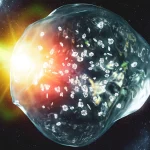
Researchers at California’s SLAC National Accelerator Laboratory have created nanodiamonds from the same material as is used to make plastic bottles
The research team was led by the Helmholtz-Zentrum Dresden-Rossendorf (HZDR) and the University of Rostock in Germany, as well as France’s École Polytechnique in collaboration with SLAC.
The researchers used a high-powered optical laser at SLAC’s Linac Coherent Light Source to briefly heat a sample of polyethylene terephthalate (PET) plastic to 10,800°F (6,000°C). This generated a shockwave that compressed the material for a few nanoseconds to a million times the atmospheric pressure.
The PET atoms then re-arranged themselves to start forming nanodiamonds with the PET’s oxygen acting as a catalyst in nanodiamond formation.
“The effect of the oxygen was to accelerate the splitting of the carbon and hydrogen and thus encourage the formation of nanodiamonds,” said Dominik Kraus professor at Rostock University and a physicist at HZDR, “it meant the carbon atoms could combine more easily and form diamonds.”
The method simulates conditions inside Uranus and Neptune where the researchers speculate that the conditions could create diamonds weighing millions of carats.







